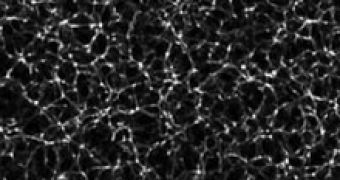Clues revealed by the recently sharpened view of the Hubble Space Telescope have allowed astronomers to map the location of invisible "dark matter" in unprecedented detail in two very young galaxy clusters.
The Johns Hopkins University-Space Telescope Science Institute team's results lend credence to the theory that the galaxies we can see form at the densest regions of "cosmic webs" of invisible dark matter, said study co-author Myungkook James Jee, assistant research scientist.
"Advances in computer technology now allow us to simulate the entire universe and to follow the coalescence of matter into stars, galaxies, clusters of galaxies and enormously long filaments of matter from the first hundred thousand years to the present," Jee said.
"However, it is very challenging to verify the simulation results observationally, because dark matter does not emit light."
Jee said the team measured the subtle gravitational "lensing" apparent in Hubble images, that is the small distortions of galaxies' shapes caused by gravity from unseen dark matter, to produce its detailed dark matter maps. They conducted their observations in two clusters of galaxies that were forming when the universe was about half its present age.
"The images we took show clearly that the cluster galaxies are located at the densest regions of the dark matter haloes, which are rendered in purple in our images," Jee said.
The work buttresses the theory that dark matter, which constitutes 90 percent of matter in the universe, and visible matter should coalesce at the same places because gravity pulls them together, Jee explained. Concentrations of dark matter should attract visible matter, and as a result, assist in the formation of luminous stars, galaxies and galaxy clusters.
Dark matter presents one of the most puzzling problems in modern cosmology. Invisible, yet undoubtedly there, scientists can measure its effects, its exact characteristics remain elusive. Previous attempts to map dark matter in detail with ground-based telescopes were handicapped by turbulence in the Earth's atmosphere, which blurred the resulting images.
Image credit: Johns Hopkins University

 14 DAY TRIAL //
14 DAY TRIAL //